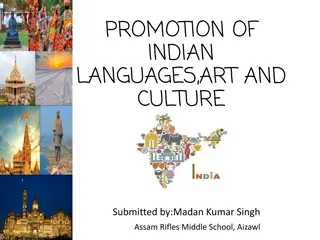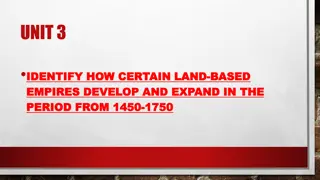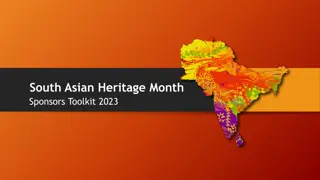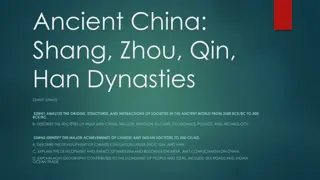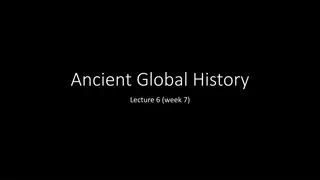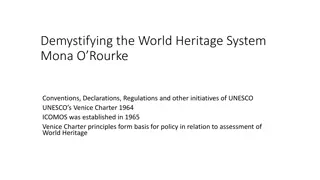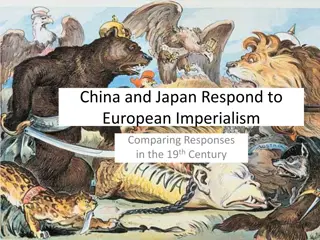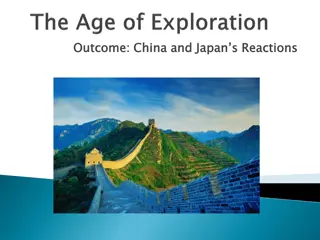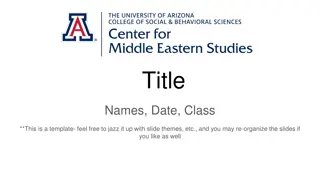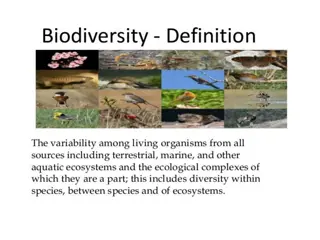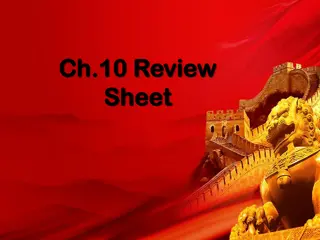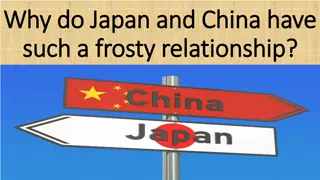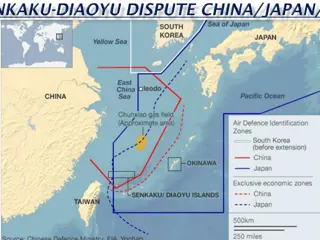Rich Heritage of East Civilization: China, India, and Persia
Explore the ancient civilizations of China, India, and Persia, delving into their unique cultures, traditions, and contributions to world history. From the theocratic despotism of China to the philosophical depth of Indian thought and the ceremonial practices of Persia, uncover the rich tapestry of the Eastern world's past, from the Shu-King to Li-King and beyond.
Download Presentation

Please find below an Image/Link to download the presentation.
The content on the website is provided AS IS for your information and personal use only. It may not be sold, licensed, or shared on other websites without obtaining consent from the author. Download presentation by click this link. If you encounter any issues during the download, it is possible that the publisher has removed the file from their server.
E N D
Presentation Transcript
East Civilization China, India, Persian
Four Regions Asian Inland river, formed by the flow of yellow and blue, and the plateau Parent Asia, China and Mongolia Ganges and Indus Valley Plain River Oxus and Jaxartes, Persian Plateau and other valley plains consisting of Euphrates and Tigris (Close Asia) Plain River Nile
China China
China In China and Mongolia theocratic despotism world history begins In China, the King is the leader of the family, most of the state law is civil law and partly moral terms, then the law has an ethical aspect. So there is a secular political life Meanwhile Mongol sovereignty confine itself to religious and spiritual forms are simple, the leader serves as lama", which is revered as a God
Shu-King Chinese tradition began 3000 years BC, and Shu King is an official document The Chinese call this the Book of the Kings (Kings) Shu-King contains the history of China, telling ancient kings reign, and the statute made by the king were presented with pictures, which is considered as the base character (the poems shaped) and is regarded as the foundation stone of Chinese meditation
Li-King Li-Ki or Li-King is a book that contains the implementation of the customs and ceremonies, in which there are attachments that Yo-King treatise on music Tshun-Tsin is a chronicle of the kingdom of Lu, the birthplace of Confucius
Science in the Eastern World Ancient philosophy of India (anviksiki / darsana) different from modern Western philosophy. In contrast to the attitude of the Greeks are more objective and rational, then the attitude of Indian people tend subjective, are more concerned with the feelings and religious magic. The burning of books by the first emperor of the Chin dynasty in the 3rd century BC helped reduce the history of science in China. But the standardization of all community needs (size, weight and currency), to help spread knowledge of arithmetic Mongolia border to the coast of North Vietnam.
China China has thousands of signs that should be studied, approximately 10,000 mark China also has a very ancient philosophy, Ratio-Tao, Lao-Tse's work, this was born the philosophy of Confucius. They believe that people who identify ratio, has the tools to achieve universal power, so as to glorify him in heaven. From the Confucian philosophy and the Book of the Kings (Kings), and several other works on morality, customs and habits form China.
China China is far behind in the fields of mathematics, physics and astronomy, although they have a lot of finesse in the field These skills are not standardized so that for example in the field of astronomy, the calculations often give them one. Proficiency they have been exploited by western scientists to create the tool, so that the Chinese calendar is made of the Europeans, so they use a boat is a boat made in Europe The touch between China and Europe occurred around the 8th century AD
India India
India Abstract unity of God and the power of nature and senses born aristocratic theocratic despotism, this is the beginning of spiritual consciousness and the distinction between secular conditions This is also confirmed by the views of the religious teachings of the caste system
India Outwardly, India sustains a variety of relationships with the history of the world Sanskrit as the foundation stone for all the languages that make up the European languages; Greek, Latin and German. India is also an emigration center for the whole of the Western world as the land of the cape of hope.
India Alexander the Great was the first to enter India (East India Company) In the British Empire, India was divided into two parts: the Deccan, a large peninsula with the bay of Bengal in the east, and the Indian Ocean on the west; Hindustan, which is formed by the Ganges valley and extends to the Persian
India Buddist Sri Lanka, India Back to the kingdom of Burma, Siam and Anam, northern Tibetan plateau and continue in China with a population consisting of the Mongols and Tartars. In China, the Buddha worshiped as Fo, in Sri Lanka as Gautama, in the Tibetan and Mongolian Lamaism. In it is contained the fundamental dogma, the absence of a principle of all things, that all things come from and return to nothingness. Various forms found in the world is only a mere modification.
The caste system In India, found a division in the period, which affects the entire life of political and religious consciousness. Humans first realized religion, and science, God, the Divine (To qeio) is the absolute universal The highest class will be one with the Divine is present and gave birth to the community, Brahmin class. The second element showing strength and courage, Ksatriya. The third class are associated with needs, Vaishya. The fourth element is the servant class, Sudras.
Persian Persian
Persian In Persian, appears as the theocratic rule of the monarchy Universal principles serve as a general principle Asian nations close (Persia) is the nation Caucasians, which includes European ancestry, they are associated with the West, while the Asian nation so far isolated The Persians were the first historical nation, and kingdom extinct first. While China and India remain unchanged and preserving its natural existence until now
Ancient Persian People Zend Persian empire is a nation, the nation of Ancient Persia (Assyrian, Median, Babylonian, Egyptian and Syrria) Zend nation (in the books Zend) are fire worshipers, traces found in Bombay and in the Caspian Sea. Zerdusht the Great, the Greeks called Zoroaster, writes religious books in the language of the Zend
Zoroastrian Religion is not worshiping Persians Idol, do not adore individual natural object, but only the universally adored Light contains spiritual meaning, is a form of goodness and truth, knowledge and willingness, and the truth that is natural. But light is also the antithesis of goodness that is evil, so that there is no light without dark. Ormuzd is the Lord of the kingdom of light, goodness and Ahriman from the kingdom of darkness, evil. But there is one universal antithesis of those affected called ZerunaeAkerene; mighty infinite
Persian Monarchy Is royal in the modern sense, which consists of a number of nations (Assyria, Babylon, Mesopotamia, Nineveh, Persia) is an independent, nurturing individuality, customs and its own laws. Persians are a nation of free mountain and nomadic, living in the land of the rich, civilized and fertile. One element of the coastal area shown by Syria Other nations under the Persian empire was Judaea. God they are the seed of Abraham and the individuality of national and local worship included in the conception of the divine
Egypt Egypt, is the unification of the various elements of adonis, Judaea, being the embodiment of the Sphinx, riddle form an ambiguous half-animal, half-human. Orisis, the Sun, the Nile, is the main idea of the Egyptian people The cult of the Egyptians are Zoolatry
Religious Ideas Idolatry Adonis




